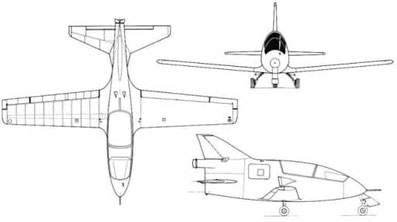
BEDE Aircraft Manuals PDF
History of Bede BD-5J Aircraft Jet
Some BEDE Aircraft Flight Manuals PDF above the page.
The BD-5J mini-plane was developed in 1971 in the USA by aircraft designer Jim Bede. After flight tests, representatives of the Guinness Book of Records awarded him the title of "the world's lightest jet aircraft."
In addition to the low weight of 162.7 kg, it also stood out for its modest dimensions - the length of the vessel was 3.66 m and the wingspan was 5.18 m.
With such a tiny size, the BD-5J was capable of accelerating to 483 km / h, and its cruising speed was 386 km / h. The baby had enough fuel for flights over 1.5 thousand km long.
Given the low price of gasoline in the United States, a private jet was cheaper than a public jet ticket.
Jim Bede tried to make the BD-5J as easy to fly as possible so that even an amateur pilot could fly a small jet.
This model was convenient not only in operation, but also in storage. After all, thanks to the removable wings, the mini-plane could fit in a regular garage.
The original price for the small aircraft was $ 1,799, but in the process of testing and subsequent improvements has risen to $ 2,599. But this did not affect the popularity of the BD-5J in the least.
In 30 months, more than 5,000 units were sold out and another 12,000 people made an advance payment to queue up for the purchase of an unusual jet. No other airline in the world can boast of such sales volumes.
A specific feature of the entire BD-5 series was that Bede Aircraft Corporation did not sell ready-made aircraft to customers, but a set of parts with detailed instructions for their assembly. The declared time for the installation of the aircraft was 600-800 hours.
In the first version of the jets, it was supposed to perform welding, and in subsequent series, all parts were connected using screws, which greatly simplified the process.
Externally, the BD-5J looks like a mixture of a fighter jet with a sports aircraft. The streamlined hull, rear propeller and ultra-light weight gave the miniature jet excellent maneuverability and speed.
This model is a frequent participant in various air shows, as it delights the audience.
Unfortunately, this aircraft cannot boast of a high level of flight safety.
So of the first 25 flights, 14 ended in a crash, as a result of which 9 people died. The main problems in the operation of the BD-5J were associated with the engine and defects in the production of parts.
When the Bede Aircraft Corporation went bankrupt in 1979, the model was discontinued.
Subsequently, many aircraft designers modified the purchased BD-5J aircraft at their discretion.
Also in the United States, several private companies have appeared to service these small jets.
Jet baby BD-5J even participated in the filming of the James Bond movie in the series "Octopus". Now the same airplane is in the Arizona State Museum.


